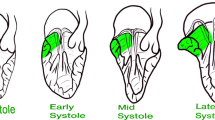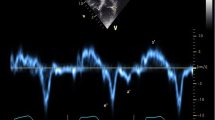Summary
In order to assess whether the paradoxical motion of the interventricular septum seen in patients with atrial septal defect (ASD) is due to a true abnormality in septal contraction, eight patients with ASD (age, 1.6–17 years) and eight age-matched control patients were studied using qualitative and quantitative two-dimensional (2D) and M-mode echocardiography. 2D-echocardiographic images recorded from the parasternal short-axis projection at the level of the papillary muscles and 2D-directed M-mode tracings at this level were obtained. Comprehensive wall motion analysis of the left ventricular (LV) endocardial and epicardial borders was performed using both fixed reference and center of mass (floating reference) models.
Our results indicate that interventricular septal wall motion and function are normal in patients with ASD. The apparent “paradoxical” motion is due to excessive anterior motion of the entire left ventricle, and is present only when a fixed reference system is used to assess myocardial motion, but is not present when a center of mass (floating reference system) is employed. Left ventricular function assessed by % area and perimeter change, mean radial shortening fraction, and mean radial wall thickening (2D) as well as LV shortening fraction and septal and posterior wall thickening (M-mode) was not significantly different between the two groups. Standard M-mode tracings can therefore be used to assess LV function despite this apparent abnormal septal motion.
Similar content being viewed by others
References
Conetta DA, Geiser EA, Oliver LH, Miller AB, Conti CR (1985) Reproducibility of left ventricular area and volume measurements using a computer endocardial edge-detection algorithm in normal subjects.Am J Cardiol 56: 947–952
Cumming GR (1978) Maximal exercise capacity of children with heart defects.Am J Cardiol 42:613–618
Diamond MA, Dillon JC, Haine CL, Chang S, Feigenbaum H (1971) Echocardiographic features of atrial septal defect.Circulation 43:129–135
Force T, Parisi AF (1986) Quantitative methods for analyzing regional systolic function with two-dimensional echocardiography.Echocardiography 3:319–331
Force T, Bloomfield P, O'Boyle JE, Pietro DA, Dunlap RW, Khuri SF, Parisi AF (1983) Quantitative two-dimensional echocardiographic analysis of motion and thickening of the interventricular septum after cardiac surgery.Circulation 68:1013–1020
Haendchen RV, Wyatt HL, Maurer G, Zwehl W, Bear M, Meerbaum S, Corday E (1983) Quantitation of regional cardiac function by two-dimensional echocardiography. I. Patterns of contraction in the normal left ventricle.Circulation 67:1234–1245
Hamilton WT, Haffajee CI, Dalen JE, Dexter L, Nadas AS (1979) Atrial septal defect secundum: clinical profile with physiologic correlates in children and adults. In: Roberts WC (ed)Congenital heart disease in adults. FA Davis, Philadelphia, p 267
Henschke CI, Risser TA, Sandor T, Hanlon WB, Neumann A, Wynne J (1983) Quantitative computer-assisted analysis of left ventricular wall thickening and motion by 2-dimensional echocardiography in acute myocardial infarction.Am J Cardiol 52:960–964
Kingma I, Tyberg JV, Smith ER (1983) Effects of diastolic transseptal pressure gradient on ventricular septal position and motion.Circulation 68:1304–1314
McCann WD, Harbold NB, Giuliani ER (1972) The echocardiogram in right ventricular overload.JAMA 221:1243
Pearlman AS, Clark CE, Henry WL, Morganroth J, Itscoitz SB, Epstein SE (1976) Determinants of ventricular septal motion: influence of relative right and left ventricular size.Circulation 54:83–91
Tajik AJ, Gau GT, Ritter DG, Schattenberg TT (1972) Echocardiographic pattern of right ventricular diastolic volume overload in children.Circulation 46:36–43
Weyman AE (1982) Interatrial and interventricular septa. In: Weyman AE (ed)Cross-sectional echocardiography. Lea and Febiger, Philadelphia, p 396
Weyman AE, Wann S, Feigenbaum H, Dillon JC (1976) Mechanism of abnormal septal motion in patients with right ventricular volume overload: a cross-sectional echocardiographic study.Circulation 54:179–186
Author information
Authors and Affiliations
Rights and permissions
About this article
Cite this article
Vincent, R.N., Saurette, R.H., Pelech, A.N. et al. Interventricular septal motion and left ventricular function in patients with atrial septal defect. Pediatr Cardiol 9, 143–148 (1988). https://doi.org/10.1007/BF02080554
Issue Date:
DOI: https://doi.org/10.1007/BF02080554




